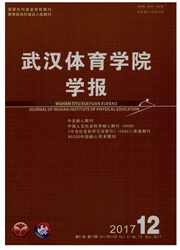

 中文摘要:
中文摘要:
目的:为了研究不同肌纤维中AMPK活性变化,并探讨其在运动过程中对自噬水平的影响,进一步阐明分子机制。方法:将18只C57BL/6雄性小鼠按体重和耐力分为安静组、运动组和力竭组,进行预适应后以15m/min的速度进行力竭运动,检测比目鱼肌和跖肌中p-AMPKa及自噬相关因子LC3、p62表达的变化,分析二者之间的调控作用。结果:P—AMPKa在比目鱼肌中、运动中表达升高。比目鱼肌中LC3-Ⅰ呈现先升高再降低的趋势,跖肌中则未检测出LC3-Ⅰ表达;而运动中LC3-Ⅱ在比目鱼肌和跖肌中的表达水平均不断升高,较安静状态具有显著性差异。比目鱼肌中p62的表达随运动进程不断升高,跖肌中p62的表达则不断下降,与安静状态相比具有非常显著性差异。结论:p—AMPKa在快慢肌纤维中的表达存在差异,运动中“能量开关”启动使慢肌纤维在运动中、力竭时自噬激活,但运动强度过大的运动却抑制自噬的程度,提示能量消耗仅能在一定程度上调控自噬水平变化,最佳的自噬水平表达可能为有氧训练等低强度运动。
 英文摘要:
英文摘要:
In order to research into the AMPK express, to discuss the effect of autophagy level in exercise, and to further clarify the molecular mechanism, eighteen C57BL/6 mice were divided into Control Group, Running Group, and Exhaustion Group by weight and endurance. The endurance exercise was 15m/min after adaptation until the exhaustion. The p-AMPKa and autophagy factor LC3, p62 of Soleus and Plantaris, and regulation between them were tested. It was show that the express of p-AMPKa in- creased in soleus and movement. The express of LC3-Ⅰ in soleus increased in running and decreased in exhaustion. LC3-Ⅰ expres- sion was not tested in plantaris. The I.C3-Ⅱ expression in mleus and plantaris were different. The p62 expression of the soleus in running increased, and the p62 expression in plantaris decreased. As compared with the Cor,.trol Group, there was a very signifi- cant difference (P〈0. 01). It could be concluded that the expression of p-AMPKa differed in slow and fast muscle fiber. The "energy switch" activated the autophagy of slow muscle fiber in Running Group and Exhaustion Group, but the intensity exercise inhibited the autophagy, suggesting that energy consumption might be only low-intensity exercise, such as aerobic training to reg- ulate autophagy level changes in the best expression.
 同期刊论文项目
同期刊论文项目
 同项目期刊论文
同项目期刊论文
 期刊信息
期刊信息
